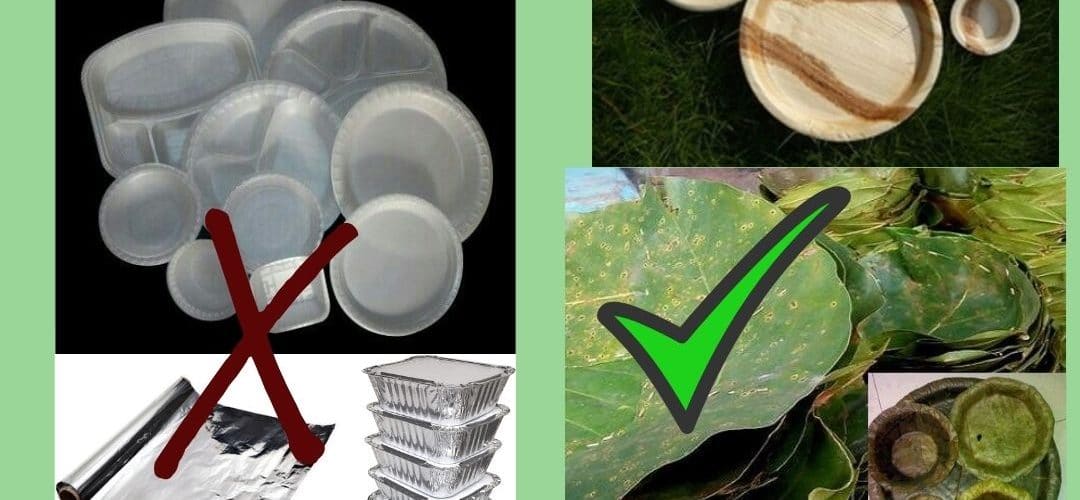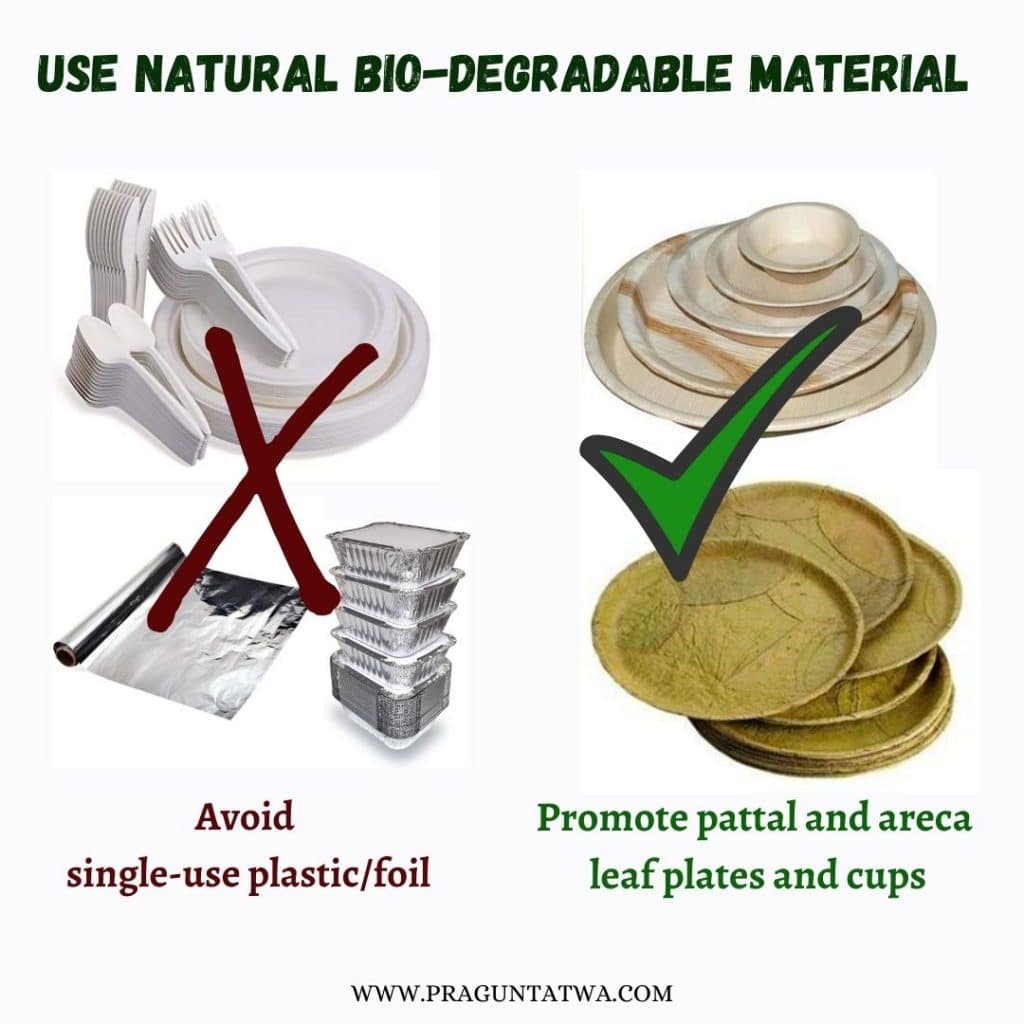Benefits of using Bio-degradable materials over disposables and single-use plastic

The waste around us is increasing manifold and the major portion of this is single-use plastic and disposables. Reusing culture is almost dying and piles of dump and garbage are rising. Just to avoid washing and carrying, people prefer single-use plastic and don’t realize that it takes up more space in landfills. The use of plastic tableware has not only damaged our physical and mental being, but also our environment. Be it a social gathering, birthday party or a casual get together, everywhere use of plastic plates has increased manifold. I agree, it makes cleaning up after an enjoyable party easier, but have you ever thought about its journey after your garbage bin. It’s the correct time we switch to bio-degradable materials.
Use bio-degradable materials for tableware and avoid single-use plastics
We don’t realize while using the disposable plates, straws, forks, spoons, and glasses, that they do not decompose and stay as it is for years. Disposables of Plastic and Styrofoam, which further put our planet’s health in danger. The plastic waste is either dumped in the landfills or gets discarded into the ocean, forests, roads, resulting in contaminated water, endangering marine and wildlife. If you worry about our environment, the damage, the dump, and looking for options, firstly ditch the disposables. Instead, start using Eco-friendly and cost-effective plates made of sal leaves, or bamboo, as they are a good alternative to non-biodegradable plastic.
It’s not that hard to switch what we used a few years back. Just a few years back plastic plates, styrofoam or thermocol, or even foil plates did not exist. Just to save ourselves from a load of washing few plates, people easily switch to single-use plastics, not even thinking once about the environment.
I stay in Nilgiris, and love to proudly share, that disposables and single-use plastic are banned here. Thermocol and styrofoam are not available in the market. I wish this becomes a norm for the entire country and world too. I’m already on a mission – not bring any single-use plastic home.

Use natural Bio-degradable materials
More developed nations are now switching to bio-degradable alternatives. Especially those which use dry leaves and Bio-Degradable materials which further has a negative impact on the environment. Many countries like Germany are now realizing the benefits of using bio-degradable plates made from dried leaves. With its multifold benefits, commercial manufacturing is now taking place. Although, the best part is, In India, we can get pattals at any general store. The traditional patravali is back because of its environment-friendly nature and biodegradability.
We can use the big and sturdy leaves of Palash and Kachmar trees and stitching them to make a plate. In north India, banana trees are not found in ample, therefore the dried leaf plates, called pattal, are popular. Distinctive leaves such as banana leaves and teak leaves are in use to serve food, in many Indiansfamilies. In India, Banana leaves are in wide use for serving. They are big and thus there is no need to stitch together unlike other smaller leaves. But we need to pick fresh banana leaves for use as they can’t be stored beyond a day or two. Also, the oval leaves of jackfruit are most commonly used in southern parts of India.
India and and use of Pattal
India carries this tradition and culture of using bio-degradable plates and tableware in pattal, banana leaves, and even sal leaves. Patravali or Pattal or Vistaraku or Vistar or Khali is a plate made with broad dried leaves. Sal leaves, or Banyan tree leaves are used to make pattal. It’s made in a circular shape, by stitching 6 to 8 sal leaves with tiny wooden sticks. the sticks are also part of the same tree. It is quite popular during traditional meals, festivals, and in temples.
In fact, India has a cottage industry where women work on weaving these plates and bowls at home in their spare time. Since ancient times, Pattal is extensively in use especially for its purity, as well as its biodegradable quality. In ceremonies and functions, it was customary to serve food in a patravali for meals or even prasadam. Pattal is one of the most eco-friendly, disposable food serving systems.
Even siali leaves are a source of living for tribal women in Odisha. Areca plates made from the shredded leaves of the Areca palm trees are also eco-friendly as well as disposable. These plates are the best alternative to plastic/polymer products and paper-based products.
Bring the change
After the pandemic and corona, we are all worried and more cautious about hygiene and safety. Every bacteria worries us, I agree the use of dried leaves might also increase our worry and hygiene concerns. Ensure we are getting it or ordering it from a well-known place so the quality is taken care of. Talking about safety I spotted this site form where you can get its supplies- https://donapattal.com/
Paper plates and plastic utensils, paper towels, napkins and tissues, disposable diapers, and single-use cheap plasticware, make up for a huge amount of waste and plastic dump. A great concern is the greenhouse gas emissions that result from the manufacturing of these items. Bring this in your daily habit and use cloth napkins, cloth rags, rechargeable batteries, cloth diapers, durable razors, and refillable coffee thermoses for take-out coffee. A plate made of green leaves, which is a whole natural leaf and has the biggest benefit that its use does not harm the environment in any way.
Switch to naturals
Various natural products and bio-degradable materials are available for use to make these plates. For Ex- recycled paper, corn starch, fallen leaves, and other natural as well as bio-degradable materials, which are also eco-friendly. So why not go green for your next party? I found this site www.ecoware.in which has an ample range of sustainable tableware.
To sum up, This is my conscious lifestyle post to spread more awareness on sustainable living. It’s Sustainable September, join me for more such ways and tips and become part of my Conscious and sustainable living ideas. Visit my blog and make yourself conscious and aware of being more concerned for our environment, and alter your lifestyle. Have you checked how to reduce and beat plastic pollution in easy 11 ways? This post is a part of Cause-a-Chatter by Blogchatter.
Being Eco-Friendly is not a choice, make it a habit.








Biodegradable plates are made from sugarcane bagasse, which is frequently regarded as agricultural waste. This minimises the agricultural sector’s carbon footprint while simultaneously reducing waste.